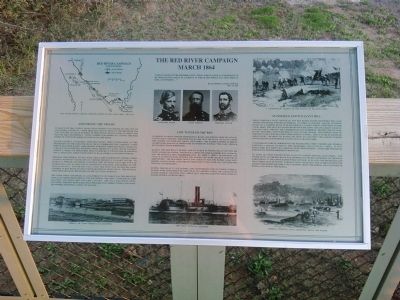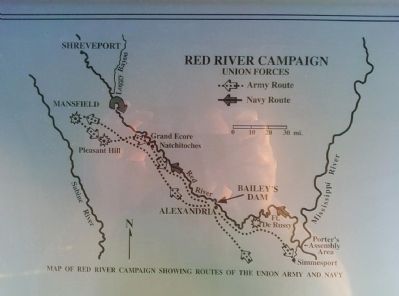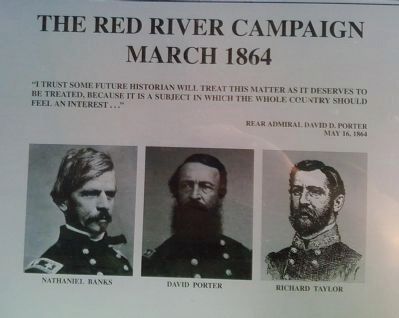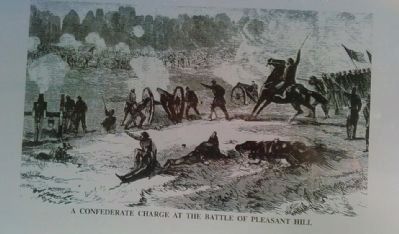Pineville in Rapides Parish, Louisiana — The American South (West South Central)
The Red River Campaign
March 1864
"I trust some future historian will treat this matter as it deserves to be treated, because it is a subject in which the whole country should feel an interest..." Rear Admiral David D. Porter May 16, 1864
Assembling the Troops
In March of 1864, nearly 30,000 troops converged on the city of Alexandria, Louisiana. Their objective was to move up the Red River and gain control of Texas in hopes of preventing Mexico from entering the war for the Confederacy. Union leaders also hoped to capture the huge stores of cotton rumored to exist along the river.
Major General Nathaniel Prentiss Banks, then commander of the Department of the Gulf, was selected to coordinate the campaign. Union forces included Banks' 15,000 troops marching from Franklin, Louisiana; 11,000 battle-hardened soldiers from Sherman's army led by General Andrew J. Smith and dispatched from Vicksburg in twenty-one transports; and a large naval force commanded by Rear Admiral David Dixon Porter.
Opposing the Federal attack were about 6,000 Confederate troops under General Richard Taylor, son of former president Zachary Taylor. On March 15, Porter and Smith captured Fort DeRussy near the town of Marksville and, facing little opposition, reached Alexandria on the following day. Taylor had evacuated the town and moved his army farther up Red River to await reinforcements from Texas. The Federal army from Franklin did not reach the city until March 24.
The Union force assembled at Alexandria in late March was the greatest display of armed might seen in the southwest. The army consisted of 25,000 infantry and artillery and 4,000 cavalry. The navy had sixty ships, including thirteen ironclads, four tinclads, five armed vessels, and many transports, mounting a total of 210 guns.
Low Water on the Red
Intending to move upriver immediately, Banks and Porter were delayed by low water on the Red. The river was so low that the fleet could not cross the "rapids," located just above Alexandria. The rapids, formed by ridges of siltstone, had given their name to "Poste du Rapides," the early French settlement established here.
Slowly the Red began to rise, and on March 26 Porter began moving his fleet across the rapids. The heavily armed steamer Eastport ran aground, and the hospital boat Woodford sank. By April 3, thirty transports and twelve gunboats had crossed the rapids and were headed upriver to Shreveport. The remaining boats, too large to pass the rapids, were left behind. Banks led his land forces north and on that same day captured the town of Natchitoches.
during the delay at Alexandria, the Confederate forces under General Taylor were reinforced by 5,000 Texas cavalrymen
under the command of Major General "Fighting Tom" Green, plus Arkansas troops commanded by Major General Sterling Price.
Mansfield and Pleasant Hill
While Porter's fleet moved up the Red River, Banks detoured his land troops westward toward Mansfield. On April 8, General Taylor attacked Banks on a narrow road near Mansfield, causing great confusion to the Union army. The next day Banks regrouped his army and attacked Taylor at Pleasant Hill, forcing the Confederates to withdraw. Despite the success, Banks' officers convinced him to give up the march. Meanwhile, part of Porter's fleet had reached Springfield Landing, about 30 miles south of Shreveport. Hearing of Banks' decision to abandon the march, Porter moved his boats downriver to join him at Grand Ecore.
Confederate forces tormented the retreating Union troops and vessels. Porter's largest gunboat, the Eastport, was sunk by a mine. It was refloated, but soon ran aground near Montgomery. With 3,000 pounds of explosives, Porter ordered it blown up.
By April 28, Union troops were again encamped around Alexandria. The water level of the Red River had dropped so low that portions of the rock formations at the upper rapids were exposed. In places, the river had less than three feet of water. Porter's fleet, including ten gunboats from the famous Mississippi squadron, was trapped above the rapids and in danger of being captured by the rebels.
Topics and series. This historical marker is listed in this topic list: War, US Civil. In addition, it is included in the Former U.S. Presidents: #12 Zachary Taylor series list. A significant historical month for this entry is March 1864.
Location. 31° 19.265′ N, 92° 26.973′ W. Marker is in Pineville, Louisiana, in Rapides Parish. Marker is on Riverfront Street west of Main Street, on the left when traveling west. Marker pavilion is located at the Forts Randolph and Buhlow State Historic Site, on the left after you go through the entrance gates. Touch for map. Marker is at or near this postal address: 135 Riverfront Street, Pineville LA 71360, United States of America. Touch for directions.
Other nearby markers. At least 8 other markers are within walking distance of this marker. Bailey's Dam (here, next to this marker); The Dam Works (here, next to this marker); Who was Stationed at Fort Randolph (approx. 0.2 miles away); Why was Fort Randolph Built? (approx. ¼ mile away); How was Fort Randolph Built? (approx. ¼ mile away); Desertion and the end of the War (approx. 0.3 miles away); Deserting soldiers and the end of the war (approx. 0.4 miles away); Who was Fort Buhlow named after? (approx. 0.4 miles away). Touch for a list and map of all markers in Pineville.
Related markers. Click here for a list of markers that are related to this marker. To better understand the relationship, study each marker in the order shown.
Credits. This page was last revised on March 18, 2017. It was originally submitted on November 24, 2010, by Lee Hattabaugh of Capshaw, Alabama. This page has been viewed 2,091 times since then and 57 times this year. Photos: 1. submitted on November 24, 2010, by Lee Hattabaugh of Capshaw, Alabama. 2, 3, 4, 5. submitted on November 29, 2010, by Lee Hattabaugh of Capshaw, Alabama. • Craig Swain was the editor who published this page.
Editor’s want-list for this marker. A clear and readable close-up photo of the marker. • Can you help?




